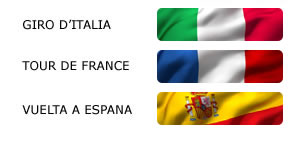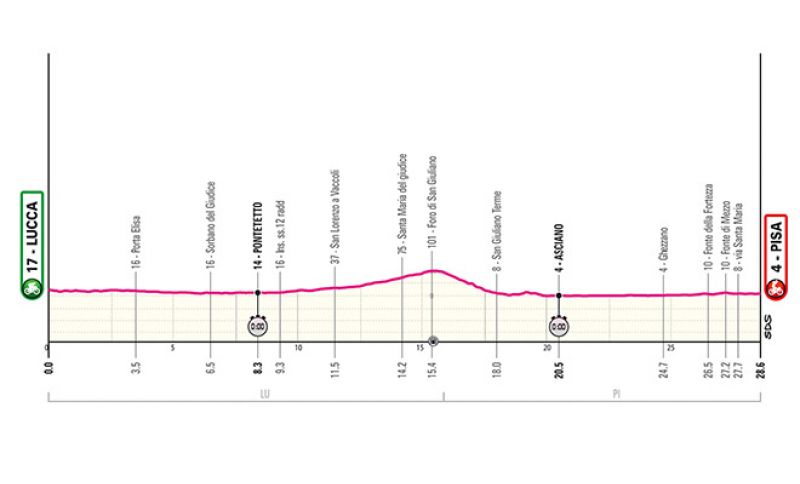

After the second rest day, the Giro d'Italia resumes its race by offering the second and final time trial of its program: traveling from Lucca to Pisa for 28.6 km.
to follow the live coverage of the entire stage starting at 1:10 PM CLICK HERE
This is an almost flat time trial with a short climb in the middle of the route. Starting in Lucca with an almost complete tour of the city walls, then reaching the Brennero state road through the southern part of the city with a series of turns. After the first intermediate checkpoint, the route becomes practically straight, always with a slight ascent until the Monti Pisani tunnel (950 m). After exiting, a series of wide and fast hairpin turns leads to San Giuliano Terme and then to the Asciano district. Always through straight roads, the route reaches the town of Pisa 3 km from the finish. Shortly after the last kilometer, it leaves the riverside road to head towards the historic center. At 500 m, a cobblestone section begins that ends at the last curve. A final 200-meter straight leads directly to the heart of Piazza dei Miracoli, at the foot of the Leaning Tower.
THE TERRITORY. The great beauty of Tuscany, in this case with two of its most fascinating art cities, embraces the riders during the tenth stage of the Giro. The brevity of the time trial also allows plenty of time to explore Lucca and Pisa, places that the world envies and that, due to their size, can be comfortably visited on foot or by bike.
4,200 meters: the complete perimeter of Lucca's walls, a grandiose Renaissance work that still embraces, and ideally protects, the city. Moreover, the entire fortified ring can be walked or cycled, allowing a view of the entire historic center from above. It's a true promenade, 30 meters wide and suspended 12 meters above the city. Unmissable. Unique.
A walk through the city center cannot ignore Via Fillungo, the social and worldly heart of Lucca, and the Torre delle Ore, 50 meters high, whose summit is reached by climbing 207 steps. The Guinigi Tower rises at the corner of Via Sant'Andrea and Via delle Chiavi d'Oro, made unmistakable by the seven holm oak trees growing on its top. Here too, one must conquer over 200 steps.
Undoubtedly less strenuous are visits to the Duomo di San Martino and the Church of San Michele, a masterpiece of Gothic-Romanesque architecture. Finally, don't miss a stop at the Puccini Museum (puccinimuseum.org) set up in the artist's birthplace, where you can admire objects belonging to the Maestro and the piano with which he composed Turandot. It's nice to imagine Puccini composing his immortal notes on locally produced paper. Lucca and Lucchesia have been, since the Middle Ages, at the center of one of Italy's most important paper production centers.
Along the road to Pisa, numerous elegant mansions of great charm can be seen, though only from the outside since most are private or hotel properties. Once out of the long tunnel connecting Lucchesia to the Pisan Plain, one encounters San Giuliano Terme, where the grand SPA palace built in 1743 by the Grand Duke of Tuscany, Francesco Stefano di Lorena, as his summer residence stands out.
Here it is, finally, Pisa. The famous Leaning Tower is already visible long before entering the city and, like a lighthouse or perhaps a magnet, leads to the destination. A must-visit is Piazza dei Miracoli, where alongside the Tower are the Cathedral (a Romanesque masterpiece consecrated in 1168) and the Baptistery, built in the same period and considered the largest in the world. Then it's lovely to get lost in the historic center's alleys, rich with leather and skin craft workshops, a productive excellence of the city. You can also admire it from above by walking along the ancient city walls. Then reach the Lungarni, along which splendid noble palaces face. Here you'll find many museums, entertainment venues, and characteristic spots to spend the evening. A special day finds its best celebration here.

Se sei giá nostro utente esegui il login altrimenti registrati.